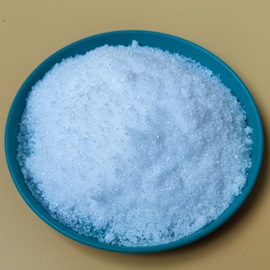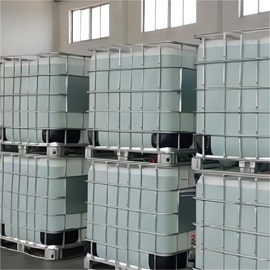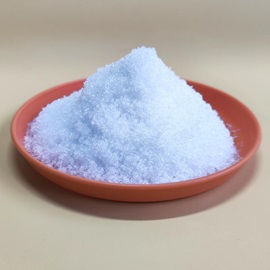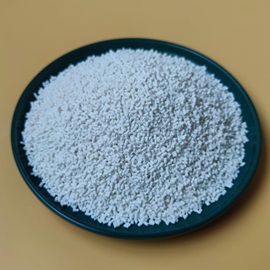Phosphorus chemicals
sodium hypophosphate|CAS10039-56-2/7681-53-0
- CAS: 10039-56-2
- MF: NaH2PO2
- Min Order Quantity: 1Kg
The phosphorus valence of sodium hypophosphate is +1, and how many metal ions and other oxides can be reduced to metal state and normal salt. And oxidants are prone to REDOX reactions. Sodium hypophosphate is widely used in concrete water-reducing agent, electroless nickel plating, water treatment, intermediates and other industries. Sodium hypophosphite solubility: 150g/100ml at 20℃. The solubility is different at different temperatures, and the higher the temperature, the higher the solubility. The solvent degree is different under different solvents, decomposition temperature: 200℃.
Physical and chemical properties
Executive standard: HG/T3253-2000
English name: Sodium Hypophosphite
Molecular formula: NaH2PO2.H2O
H.S code: 28351000.00
CAS Number: 10039-56-2(monohydrate/Industrial grade finished product)/7681-53-0(anhydrous substance/Special reagent grade)
Molecular weight: 105.99
Solubility: soluble in water, insoluble in propanol, insoluble in ethanol. Solubility in water at room temperature is about 150g/100ml water
PH: 6- 8
Melting point, 125.1 -127.4℃
Appearance: White crystal, easy to absorb moisture
Decomposition temperature: At 200℃, sudden decomposition occurs and PH3 is precipitated
Danger and shipping category: general cargo
Export tax rebate rate: 0%
Technical index
Assay≥101.0%
Na2HPO3≤0.50%
SO4≤100mg/kg
Cl≤100mg/kg
PH: 6.0-8.0
Ca≤50mg/kg
Fe≤5mg/kg
Pb≤5mg/kg
As≤5mg/kg
Cd≤5mg/kg
Cr≤5mg/kg
Detection method
It's basically a titration. Detection and analysis were performed according to the methods and steps of national standard HG 3253-2009.Weigh 0.8g sodium hypophosphate (read to 0.0002g), dissolve with water, transfer to 250ml volumetric bottle, dilute to scale, shake well. Use a pipette to remove 25ml test solution and place it in 250ml iodine bottle. Then add 50ml bromine solution with pipette and quickly add 10mlH2SO4 solution, close the bottle cork and water seal immediately, and slowly shake well. Place in a dark place at 15-25 ℃ for 1h. Then quickly add 10ml potassium iodide solution (200g/l), plug tightly, water seal, slowly shake well. After 10min, wash the bottle stopper with water, titrate with sodium thiosulfate standard titration solution until the test solution becomes light yellow, add 2ml starch indicator solution, and continue titrating under vigorous shaking until the blue color of the solution disappears, which is the end point. At the same time, the blank test was carried out.
Application description
1, flame retardant production raw materials. It is an important reducing displacer in the production of halogen-free flame retardants and phosphorus-nitrogen flame retardants. As a halogen-free flame retardant, it is the most developed new process in China for several years.
2, the preparation of hypophosphate, the domestic hypophosphate is basically prepared by sodium hypophosphate through ion exchange resin method. Hypophosphoric acid is widely used in pharmaceutical industry.
3. Fresh-keeping agent. In overseas can be used as food preservatives, antioxidants, belong to a food additive (except China).
4, electroless plating, electroplating welcome agent. It can reduce nickel, copper and gold in the plating solution to a metallic state. Electroless reducing agent, and nickel sulfate in accordance with 1:1 electroless plated metal surface with corrosion and wear resistance, uniform dense, solid phosphorus nickel gold coating, can be used for stainless steel materials, widely used in electronics, machinery, petroleum, foundry, aviation, navigation, food, medicine and other industries.
5, water treatment agent. It is one of the raw materials for the production of sewage treatment agent.
6, concrete water reducer. In recent years, as one of the raw materials, the use of concrete polycarboxylic acid water reducer industry has increased year by year.
Sodium hypophosphate is basically prepared by yellow phosphorus base reaction, which has the effect of low cost, high efficiency and simple treatment. Yellow phosphorus is heated with a mixture of lime milk and sodium carbonate solution in an inert atmosphere to release phosphine and hydrogen. After the reaction, the reactants are filtered, the filtrate is sodium hypophosphate solution, and the filter cake is composed of unreacted lime, calcium phosphite and calcium phosphate. The liquid is passed through carbon dioxide to remove the calcium hydroxide dissolved in it, filtered, the filtrate is reduced pressure and concentrated, and finally sodium hypophosphite is obtained
News
Contact Us
Contact: HXOSC
Phone: +86-512-36622455 +86-13358057724(WhatsApp)
Tel: +86-512-36622455+86-13358057724
E-mail: Hxo@hxochem.com Support@hxochem.com logistic@hxochem.com
Add: No. 1377, Fuchunjiang Road, Kunshan Development Zone, Jiangsu Province, China



